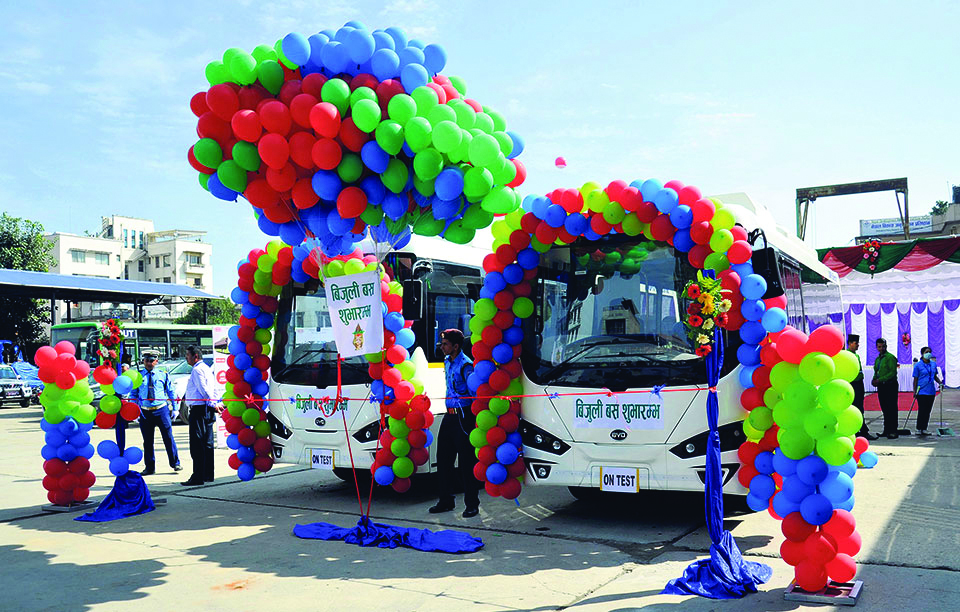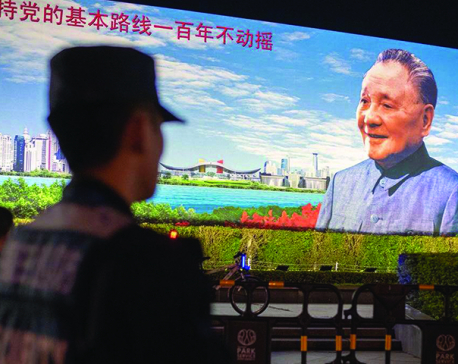
OR


Ashish Gajurel and Prashant Raj Pandey
Gajurel is a transport expert and Pandey is currently a graduate student at Crawford School of Public Policy, Australian National Universitynews@myrepublica.com
More from Author
Nepal should aim for promoting electric vehicle technology. Strategic approach should be adopted to formulate policies to encourage people to shift to electric vehicles
Nepal faces a burgeoning trade deficit of 127.34 billion rupees. Import of motor vehicles and the subsequent import of petroleum to power these vehicles has been one of the biggest contributors fueling the deficit. To gain a perspective, look at the statistics. As of last fiscal year, there were 32, 21,042 registered vehicles in the country, marking a 16 percent increase from 27, 83,428 vehicles of previous fiscal. Motor vehicle ownership has been increasing on an average of 20 percent per annum, soaring the demand for petroleum products. Refined petroleum products amounting to $1.04 billion were imported in 2017, making for around 11 percent of the total imports. The increase in emissions due to higher burning of fossil fuels has exacerbated air pollution, particularly in the urban areas with higher concentration of registered vehicles. Adoption of electric vehicle technology can be a feasible strategy to tackle air pollution and widening trade deficit.
Electric vehicles are in use currently, both at the private and government levels, but the number is negligible. The federal and provincial governments have communicated their plans to prioritize purchase of electric vehicles. The federal government has recently decided to operate 300 electric buses in Kathmandu valley. Province 3 and Sudur-Paschim province have also brought out plans to operate electric buses. Importing these vehicles might stress out our foreign exchange reserves, but the reduction in fuel imports will compensate this financial burden.
We need electric vehicles to reduce pollution and trade deficit. But buyers do not think of it this way, for their main motive is to maximize profits. Electric vehicles are costlier than their fossil fuel counterparts, and as such are unlikely to be adopted if left alone to market forces.
Where are incentives?
Governments across the globe are incentivizing adoption of electric vehicles. Government of Nepal has been providing its own set of incentives in the form of customs duty rebates to public and private electric vehicles (one percent for public and 10 percent for private). But this is significantly low compared to the normal rate which stands at 225 percent for private petroleum vehicles. With just about 4500 registered electric vehicles in the country till date, the existing incentives have failed to substantially increase this number.
An incentive that doesn’t work is as bad as having no incentive at all. What Nepal lacks is a strategic approach to encourage adoption of electric vehicles. Both India and China have core strategies in place to turn electric. India has outlined a vision to have an all-electric vehicle fleet by 2030. It has launched a National E-Mobility Program which focuses on public procurement to facilitate demand for electric vehicles in India. The program also aims to create the necessary charging infrastructure and policy framework to meet 30 percent target of electric vehicles by 2030. China currently has the largest number of electric vehicles and has been providing financial incentives to both the manufacturers and end consumers. The National Electric Vehicle Subsidy Program grants subsidies based on three characteristics—vehicle range, energy efficiency and battery pack density. The incentives have been designed to push manufacturers to produce electric vehicles with a higher mileage range. China is also actively seeking to promote an electric transport fleet, including public transportation. The Chinese city of Shenzhen completely transformed its urban fleet of 16,359 buses to electric models in 2017.
Europe is moving forward faster in this direction. Sweden plans to implement petroleum fuel-free transportation system by 2030. Other developed countries have also implemented various schemes to encourage adoption of electric vehicles. With hydropower as the only major source of energy produced domestically, Nepal should aim at promoting the electric vehicle technology. A strategic approach should be adopted to formulate policies that encourage people to shift to electric vehicles.
Learn from others
Nepal needs to learn from the best practices in incentivizing adoption of electric vehicles. While the current incentives are sustainable from a fiscal perspective, they’re grossly inadequate to promote electric vehicles. Subsidy approach is a tried and tested model for promoting electric vehicles. Under this model, a subsidy or tax credit is provided, which reduces the upfront costs of manufacturing or purchase of electric vehicles. The government can lead from the front, initiating public procurement for electric vehicles. Such a process must also incentivize establishment of manufacturing within Nepal.
Equally important is creating enabling infrastructure. A mid-sized electric vehicle has an operational mileage of 160-170 kilometres per charge. Without adequate charging infrastructure, electric vehicles will be limited to daily commute within urban cities. This requires huge investments in infrastructure, which can be financed through a Public-Private Partnership model. As a first step, the government can fund the state-owned Nepal Electricity Authority to establish electric charging stations. Private investment will flow in the electric vehicle sector only when the government is firmly committed to promoting electric vehicle adoption. To reduce the uncertainty surrounding policy on electric vehicles, the government must clearly communicate its strategic plan, with details on the types of incentives and the timeframes for which they will be applicable. The long-term perspective must be to encourage manufacturing of electric vehicles in Nepal itself.
Management of battery is another challenge. In general, the battery of a small vehicle lasts up to 7 to 10 years while that for larger vehicles needs a replacement every 3 to 5 years. Though unsuitable for re-use in the vehicles, such batteries still have 70 percent of their original capacities and can be utilized to power home appliances or as backup for solar power. However, after certain time point, these batteries will have to be recycled. Almost all countries encouraging battery powered electric vehicles are facing the problem associated with management of used batteries. The European Union requires the manufacturer of batteries to finance the cost of collecting, treating and recycling all collected batteries. China has the provision that enforces producers to take responsibility of recycling used batteries. Countries that do not produce electric buses normally return the used batteries to the producers for recycling. For instance, Malaysia purchases electric vehicles from China and returns the used batteries to the supplier for recycling. Nepal should also adopt this strategy to manage the used batteries as we lack recycling infrastructure.
An overnight shift to electric vehicles is not possible. The government must take time to formulate solutions that suit Nepal’s unique needs. These might include conversion of petroleum powered vehicles into electric or even incentivizing electric two-wheelers, taking into consideration the issue of affordability that discourages adoption of electric vehicles. It’s high time the government worked on a long-term strategy on promoting electric vehicles in Nepal.
Gajurel is a transport expert and Pandey is currently a graduate student at Crawford School of Public Policy, Australian National University
You May Like This

Confessions of a socialist
We march on steadily toward a socialist nation that offers a brighter and better future than anything we have seen... Read More...

In defense of private schools
Why can’t an entrepreneur open a private school and make profit in the process? Why don’t we let the market... Read More...

Reconciling security and growth
“America First” approach taken by the US will strengthen China’s own hardliners, who will push to emphasize national security over... Read More...










Just In
- Heavy rainfall likely in Bagmati and Sudurpaschim provinces
- Bangladesh protest leaders taken from hospital by police
- Challenges Confronting the New Coalition
- NRB introduces cautiously flexible measures to address ongoing slowdown in various economic sectors
- Forced Covid-19 cremations: is it too late for redemption?
- NRB to provide collateral-free loans to foreign employment seekers
- NEB to publish Grade 12 results next week
- Body handover begins; Relatives remain dissatisfied with insurance, compensation amount







Leave A Comment